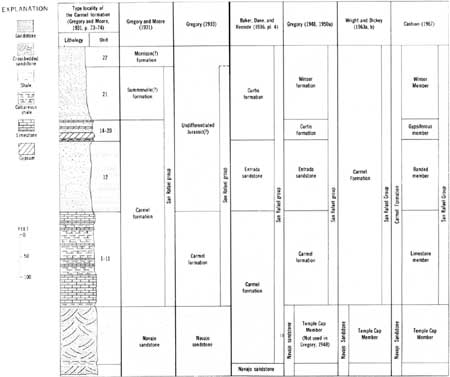
|
Geological Survey Bulletin 1244-J
Carmel Formation of The Zion Park Region Southwestern Utah - A Review |
STRATIGRAPHY
SECTION
The stratigraphic section given below is an abbreviated version of one published in Gregory and Moore (1931, P. 73-74). It is a composite made up of five partial sections measured at the type locality of the Carmel Formation. Although this section was not designated as the type section, it has become the standard for comparison. Fossil listings have been omitted but fossiliferous beds are indicated. More recent and complete paleontologic information is given by Imlay (1964) and Sohl (1965). Unit numbers correspond to those shown on figure 2. The abbreviated descriptions, with bracketed entries by the author, are as follows:
Section of Carmel Formation between Virgin River
bridge (approximately 2 miles south-southwest of Mount Carmel) and a point
about 2 miles west of Mount Carmel village, Utah
[Adapted from Gregory and Moore (1931, P. 73-74.
Section measured by Herbert E. Gregory)]
| Feet | |
| Morrison(?) Formation: | |
| 22. Sandstone, white; contains green shale | 50 |
| Summerville (?) Formation: | |
| 21. Sandstone, banded alternately pale red and white | 130 |
| Carmel Formation: | |
| 20. Limestone, gray, sandy, oolitic in part; fossiliferous | 1/3 |
| 19. Sandstone, banded pale red and white | 13 |
| 18. Gypsum, white, lumpy | 3 |
| 17. Sandstone, red and green, white-banded | 12 |
| 16. Gypsum, white-green | 16 |
| 15. Shale, white, gypsiferous and arenaceous | 2 |
| 14. Gypsum, white and green; pink lenses near top | 4 |
| 13. Unconformity. | |
| 12. Sandstone beds 4 in. to 6 ft. thick | 68 |
[In a revised description of this section, Gregory (1950a, p. 127) showed thickness of this unit to be 168 ft. Later figure is more accurate.] | |
| 11. Limestone, light-gray to cream; fossiliferous | 28 |
| 10. Shale, gray to buff, calcareous | 10 |
| 9. Limestone, cream, dense, hard, siliceous; contains thin lenses and seams of chert | 1-1/2 |
| 8. Shale like No. 6 | 35 |
| 7. Limestone, buff, earthy, one massive bed; top consists largely of broken shells | 2 |
| 6. Shale, calcareous and arenaceous, and thin, earthy limestone, gray to cream; fossiliferous | 22 |
| 5. Sandstone, gray to buff, very calcareous, fossiliferous | 4 |
| 4. Limestone and calcareous shale | 18 |
| 3. Limestone, cream; earthy at bottom; few feet pink; very sandy in cliff sections | 20 |
[As described here, the total thickness of units 3-11 is 140-1/2 ft. In a revised description of this section, Gregory (1950a, p. 127) showed total thickness of same sequence (included in units 3-15) to be approximately 218 ft. Later figure is more accurate.] | |
| 2. Shale, brick-red | 5 |
| 1. Sandstone, green-white; in places conglomerate with red quartz grains, green mud pellets, and shale fragments | 6 |
| Total Carmel Formation | 269+ |
LITHOLOGIC SUBDIVISIONS
As a result of recent work (Wright and Dickey, 1963a, b) the upper boundary of the Carmel Formation has been moved stratigraphically higher and the formation now includes all beds in the measured section just presented. This sequence in the Zion Park region can be divided into four members which are recognizable throughout the region. The dominant lithologies are, in ascending order, (1) limestone and calcareous shale with argillaceous siltstone or sandstone at base, units 1-11 on figure 2; (2) red and gray banded sandstone, unit 12 on figure 2; (3) massive gypsum and gypsiferous shale and sandstone, with limestone at top in most of the region, units 14-20 on figure 2; and (4) light-gray and pale-red sandstone, units 21-22 on figure 2.

|
| FIGURE 2.—Stratigraphic nomenclature of the Carmel Formation and associated units as applied by various workers in the Zion Park region, Utah. (click on image for an enlargement in a new window) |
AGE
Significant fossil collections have been taken from the limestone member and a few collections of poorly preserved nondiagnostic fossils from the limestone at the top of the gypsiferous member. The fossils indicate that the age of the limestone member is Middle Jurassic to possibly early Late Jurassic, and the stratigraphic position of the members above it indicates that they are probably early Late Jurassic (Imlay, 1964, p. C3-C5).
| <<< Previous | <<< Contents >>> | Next >>> |
bul/1244-J/sec1.htm
Last Updated: 28-Mar-2006